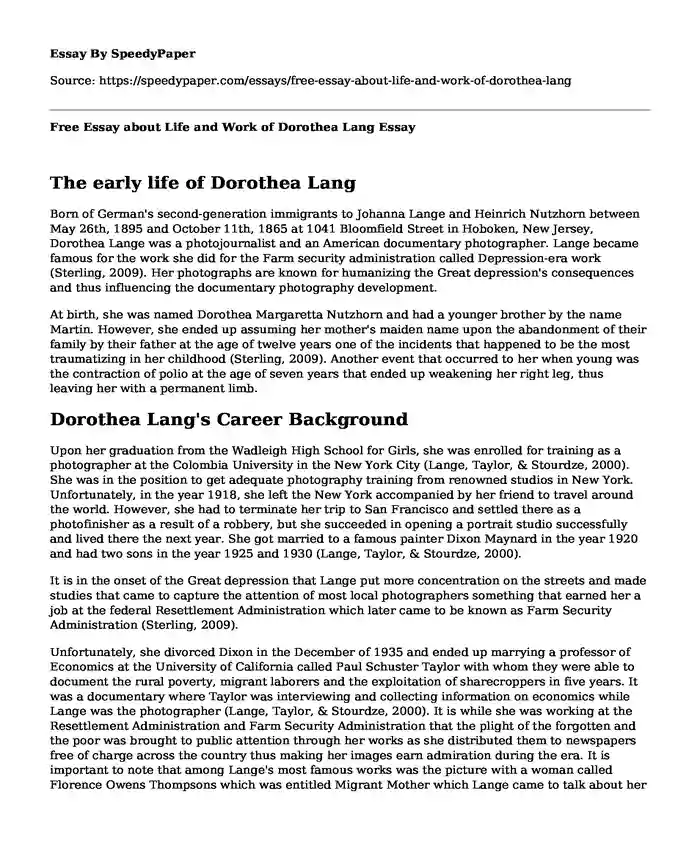The early life of Dorothea Lang
Born of German's second-generation immigrants to Johanna Lange and Heinrich Nutzhorn between May 26th, 1895 and October 11th, 1865 at 1041 Bloomfield Street in Hoboken, New Jersey, Dorothea Lange was a photojournalist and an American documentary photographer. Lange became famous for the work she did for the Farm security administration called Depression-era work (Sterling, 2009). Her photographs are known for humanizing the Great depression's consequences and thus influencing the documentary photography development.
At birth, she was named Dorothea Margaretta Nutzhorn and had a younger brother by the name Martin. However, she ended up assuming her mother's maiden name upon the abandonment of their family by their father at the age of twelve years one of the incidents that happened to be the most traumatizing in her childhood (Sterling, 2009). Another event that occurred to her when young was the contraction of polio at the age of seven years that ended up weakening her right leg, thus leaving her with a permanent limb.
Dorothea Lang's Career Background
Upon her graduation from the Wadleigh High School for Girls, she was enrolled for training as a photographer at the Colombia University in the New York City (Lange, Taylor, & Stourdze, 2000). She was in the position to get adequate photography training from renowned studios in New York. Unfortunately, in the year 1918, she left the New York accompanied by her friend to travel around the world. However, she had to terminate her trip to San Francisco and settled there as a photofinisher as a result of a robbery, but she succeeded in opening a portrait studio successfully and lived there the next year. She got married to a famous painter Dixon Maynard in the year 1920 and had two sons in the year 1925 and 1930 (Lange, Taylor, & Stourdze, 2000).
It is in the onset of the Great depression that Lange put more concentration on the streets and made studies that came to capture the attention of most local photographers something that earned her a job at the federal Resettlement Administration which later came to be known as Farm Security Administration (Sterling, 2009).
Unfortunately, she divorced Dixon in the December of 1935 and ended up marrying a professor of Economics at the University of California called Paul Schuster Taylor with whom they were able to document the rural poverty, migrant laborers and the exploitation of sharecroppers in five years. It was a documentary where Taylor was interviewing and collecting information on economics while Lange was the photographer (Lange, Taylor, & Stourdze, 2000). It is while she was working at the Resettlement Administration and Farm Security Administration that the plight of the forgotten and the poor was brought to public attention through her works as she distributed them to newspapers free of charge across the country thus making her images earn admiration during the era. It is important to note that among Lange's most famous works was the picture with a woman called Florence Owens Thompsons which was entitled Migrant Mother which Lange came to talk about her experience taking that photograph in the year 1960 (Phillips, 2000).
Lange got the Guggenheim Fellowship award for her photography achievements in the year 1941and got a job from the War Relocation Authority to capture the forced evacuation of Japanese Americans from the west coast after the attack on Pearl Harbor. She traveled across the rural and urban California to take photographs of the families as they prepared to leave as well as the incarceration that followed after that with her highlighting the first of the permanent internment camps called Manzanar (Phillips, 2000). Her caption of the Japanese American children pledging allegiance to the US flag upon being sent to the incarceration camps was one of the most haunting reminders to most observers of this act of putting people on incarceration camps without trial. It is as a result of the critical nature of most of her images that the US army impounded most of them to avoid them being seen publicly during the war. However, the pictures of the internment can now be found in the US national archives, and everyone can access them (Phillips, 2000).
Lange together with Pirkle Jones co-founded the Aperture which was a photographic magazine in the year 1952. As a result, they were allowed to capture a detailed documentary for the Life magazine of Monticello's death in the mid-1950's as well as the shooting of the displacement of California's citizens by the process of forming Lake Berryessa through the damming of Putah Creek (Sterling, 2009).
Dorothea Lang's Demise and Legacy
Lange experienced poor health during the last two decades of her life as she suffered from post-polio syndrome as well as gastric problems despite the effects of polio not being recognized by doctors. She thus succumbed to esophageal cancer on the 1st of October in the year1965 at the age of 70 years in San Francisco, California. She was incorporated into the National Women's Hall of Fame in the year 2003 and an elementary school named in Nipomo, California in the year 2006 (Sterling, 2009).
References
Lange, D., Taylor, P. S., & Stourdze, S. (2000). An American exodus: A record of human erosion. Paris: Jean Michel Place.
Phillips, S. S. (2000). Lange, Dorothea (1895-1965), photographer. American National Biography Online. doi:10.1093/anb/9780198606697.article.1700504
Sterling, C. H. (2009). Encyclopedia of journalism: 1. Thousand Oaks, CA: Sage.
Cite this page
Free Essay about Life and Work of Dorothea Lang. (2022, Mar 31). Retrieved from https://speedypaper.com/essays/free-essay-about-life-and-work-of-dorothea-lang
Request Removal
If you are the original author of this essay and no longer wish to have it published on the SpeedyPaper website, please click below to request its removal:
Popular categories





